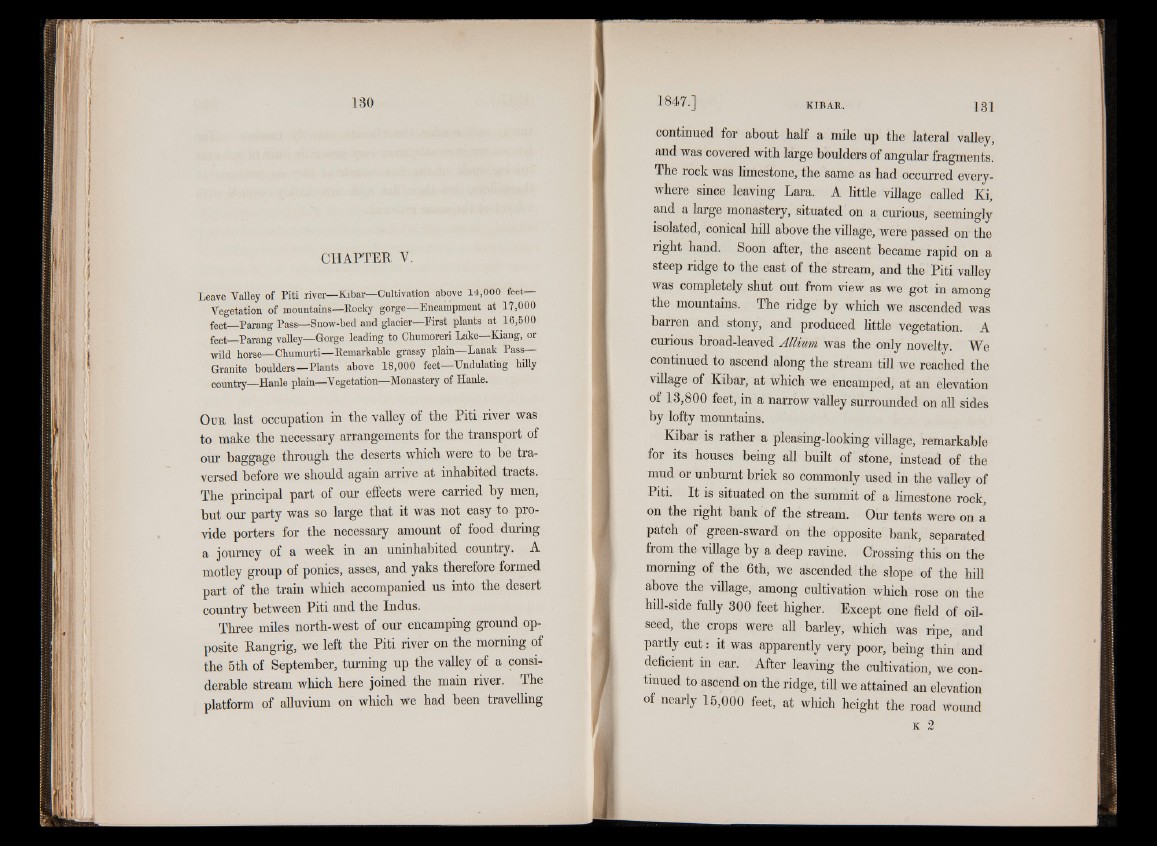
CHAPTER V.
Leave Valley of Piti r iv e r— Kibar—Cultivation above 14,000 feet—
Vegetation of mountains—Rocky gorge—Encampment at 17,000
feet—Parang P a s s— Snow-bed and glacier—First plants at 16,500
feet Parang valley— Gorge leading to Chumoreri Lake Kiang, or
wild horse— Chumurti— Remarkable grassy plain—Lanak Pass—
Granite boulders—Plants above 18,000 feet—Undulating hilly
country—Hanle plain—Vegetation—Monastery of Hanle.
Our last occupation in tlie valley of tlie Piti river was
to make the necessary arrangements for the transport of
our baggage through the deserts which were to be traversed
before we should again arrive at inhabited tracts.
The principal part of our effects were carried by men,
but our party was so large that it was not easy to provide
porters for the necessary amount of food during
a journey of a week in an uninhabited country. A
motley group of ponies, asses, and yaks therefore formed
part of the train which accompanied us into the desert
country between Piti and the Indus.
Three miles north-west of our encamping ground opposite
Rangrig, we left the Piti river on the morning of
the 5th of September, turning up the valley of a considerable
stream which here joined the main river. The
platform of alluvium on which we had been travelling
continued for about half a mile up the lateral valley,
and was covered with large boulders of angular fragments.
The rock was limestone, the same as had occurred everywhere
since leaving Lara. A little village called Ki,
and a large monastery, situated on a curious, seemingly
isolated, conical hill above the village, were passed on the
right hand. Soon after, the ascent became rapid on a
steep ridge to the east of the stream, and the Piti valley
was completely shut out from view as we got in among
the mountains. The ridge by which we ascended was
barren and stony, and produced little vegetation. A
curious broad-leaved Allium was the only novelty. We
continued to ascend along the stream till we reached the
village of Kibar, at which we encamped, at an elevation
of 13,800 feet, in a narrow valley surrounded on all sides
by lofty mountains.
Kibar is rather a pleasing-looking village, remarkable
for its houses being all built of stone, instead of the
mud or unburnt brick so commonly used in the valley of
Piti. It is situated on the summit of a limestone rock,
on the right bank of the stream. Our tents were on a
patch of green-sward on the opposite bank, separated
from the village by a deep ravine. Crossing this on the
morning of the 6th, we ascended the slope of the hill
above the village, among cultivation which rose on the
hill-side fully 300 feet higher. Except one field of oilseed,
the crops were all barley, which was ripe, and
partly cut: it was apparently very poor, being thin and
deficient in ear. After leaving the cultivation, we continued
to ascend on the ridge, till we attained an elevation
of nearly 15,000 feet, at which height the road wound